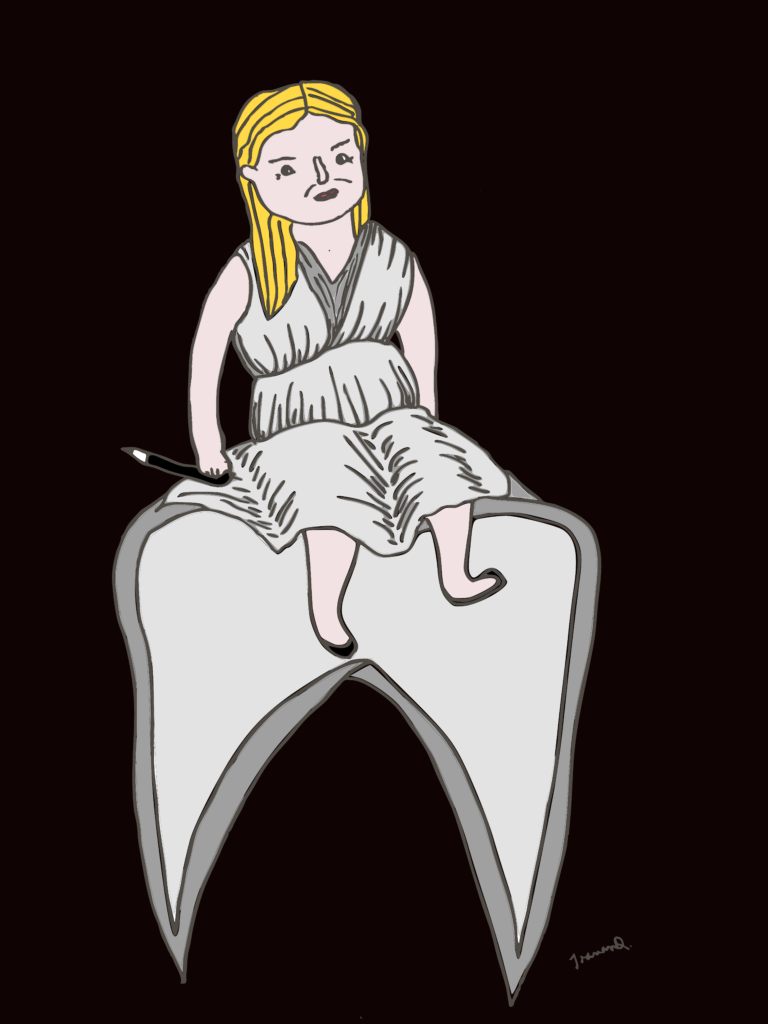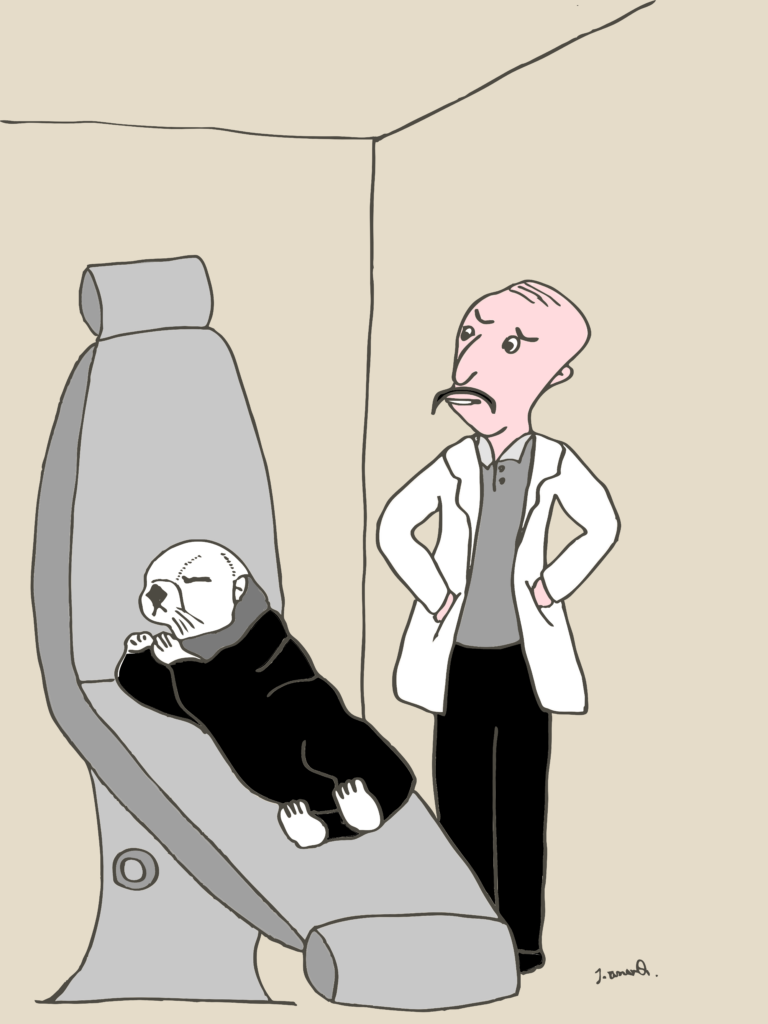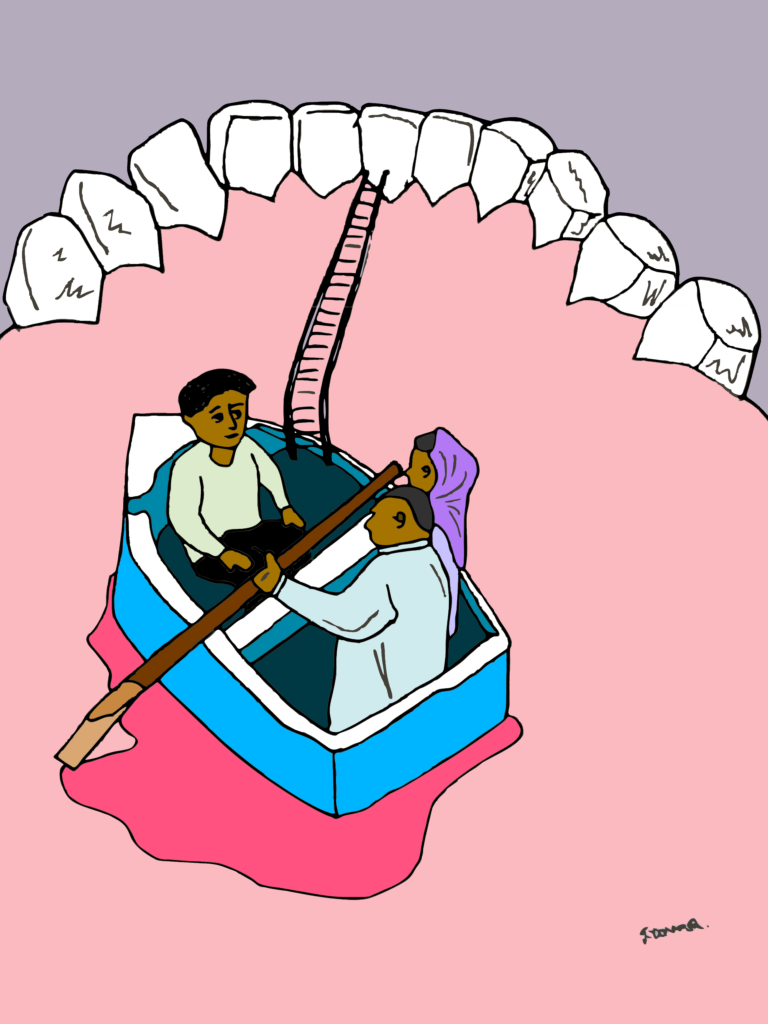Teeth are comical. Even when you suffer an infection from a toothache, people don’t feel guilty laughing at your swelling face. It’s not like you’re going to die or anything.
All that makes teeth an good vehicle for humor. I once read a love poem with a line that went something to the effect of, “I cannot tell who gives me more pain / You or my teeth.”

Problems arise when teeth are asked to serve as serious metaphors. Teeth seem to be too trivial to be deep. In Hans Christian Andersen’s 1872 parable “Aunty Toothache,” a young aspiring poet struggles with his bad teeth. One day, Aunty Toothache—a Muse-like figure—offers him a deal: She will cure his toothache, but if she does, he’ll never write another poem again. He accepts. Andersen intends to compare creative pain to a toothache. Back in his day, a toothache could prove fatal; today, it’s no big deal. I don’t know what to make of this young poet’s decision.

In John Updike’s 1955 story “Dentistry and Doubt,” a young theology student experiences an epiphany at the dentist. The student’s mind begins to wander: Could the anesthesia weaken his faith? Why does God sit idly by as some men struggle and perish? Receiving a dental filling seems too small and routine a procedure to trigger such thoughts, but maybe that is Updike’s point: The student is so naïve that even the most mundane experience feels like a revelation. Then again, we’re not sure. Everything happens inside the student’s mind. The dentist remains a purely decorative figure. In the end, the student leaves the appointment pondering a quote by Richard Hooker, the sixteenth-century theologian on whom the student is writing his thesis: “I grant we are apt, prone, and ready, to forsake God; but is God as ready to forsake us? Our minds are changeable; is His so likewise?” I know I’m supposed to find the quote illuminating, but I feel indifferent as the dentist does in the story.

Teeth are explicit. They lack the subtlety that great literature demands. White Teeth is a fascinating novel. But if anything reveals Zadie Smith’s anxiety as a then-emerging writer, it’s the teeth metaphors. It’s as though Smith wants to provide some obvious symbols for literature students to write papers about. Her emphasis on teeth often undermines the believability of her characters. Clara Bowden is “the most beautiful thing” Archie Jones has ever seen, but when she grins, Jones detects her “one imperfection”: Bowden has buck teeth. I used to have buck teeth as a teenager; they change your face and the way you smile—how could Jones not have noticed it before she grins?
Smith also uses “root canal” to suggest her immigrant characters’ efforts to connect to their roots, home, and cultural heritage. Samad Iqbal insists to build the “root canal,” to send his son Magid back to his Bengali community. In dentistry, however, a root canal is a treatment to repair a severely decayed tooth, and because Smith associates tooth decay with moral stigmas in the novel, the symbolic meaning of “root canal” contradicts the novel’s other teeth metaphors.
My favorite moments in White Teeth are those without the teeth. In her later works, a more confident Smith goes much easier on the metaphors.

Teeth are “anti-poetic,” wrote critic Michael Redgrave in 1929. But maybe more writers should take advantage of this. Joshua Ferris’s 2014 novel To Rise Again at a Decent Hour presents teeth along with other contemporary objects: floss, Red Socks memorabilia, cellphones. His protagonist, a successful dentist, has trouble connecting with others and feels that life lacks purpose. On the first page, the dentist imagines his patients at home: “[T]he minute he takes up the floss, [he] says to himself, What’s the point.” For Ferris’s character, contemporary life shares the same subtext to teeth: mundane, superficial, awkward. We’re all dying for a revelation.
In many ways, Ferris achieves where Updike fails in “Dentistry and Doubt.” Still, some readers may dislike Ferris’s novel for its oppressive realism. It’s like walking into an art museum that looks exactly like your living room. You know the exhibition is meant to be a satire. But, having driven an hour to get there, you find yourself asking, Why bother.

Andersen and Updike had troubled relationships with their teeth; I suspect they searched for relief in their stories. (The divinity student in “Dentistry and Doubt,” for example, is a Pennsylvania native who visits Oxford as an exchange student, the same as Updike.) But teeth make a flawed metaphor, too mundane to be tragic and too superficial to be profound. I await the the first great contribution to dental literature.
The post Dentistry and Doubt: On Writing About Teeth appeared first on The Millions.











